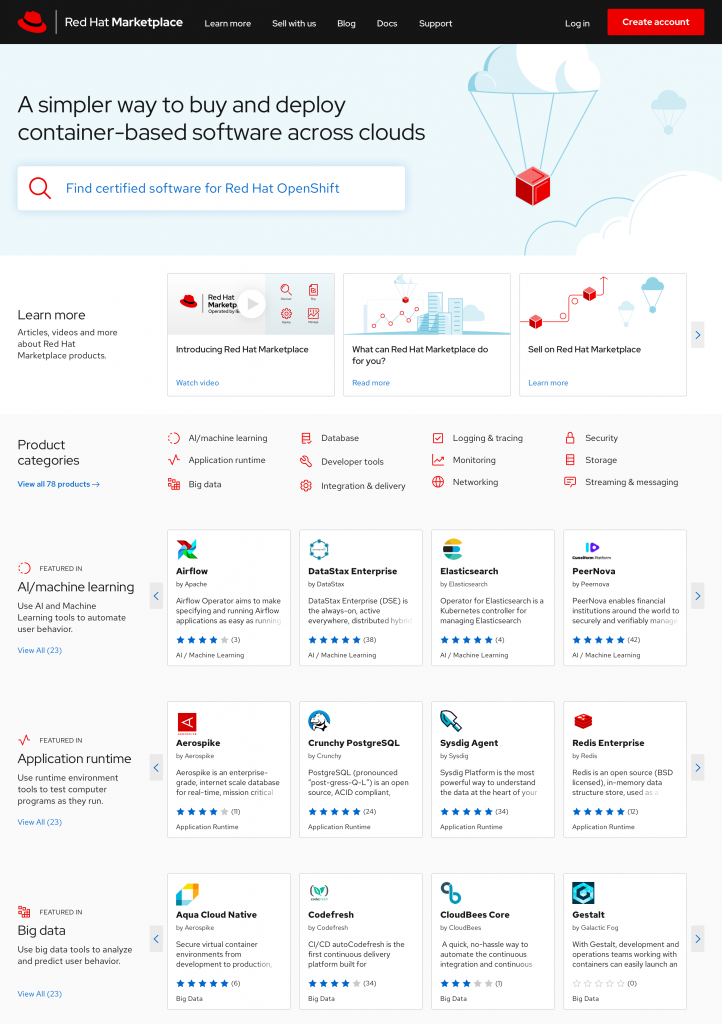Red Hat Unfurls OpenShift Marketplace Managed by IBM
Red Hat, in collaboration with parent company IBM, announced this week the opening of Red Hat Marketplace, an online store through which it will make available software developed by both organizations as well offerings from third-party partners that have created software that runs on the Red Hat OpenShift platform.
In addition, Red Hat is giving organizations the option of licensing Red Hat Marketplace Select, an instance of the same catalog platform that can be employed to create a portal through which they can make curated instances of commercial and custom applications available to their internal customers.
Both Red Hat Marketplace and Red Hat Marketplace Select are being operated by IBM on behalf of Red Hat customers who have standardized on the Red Hat OpenShift platform, which is based on a distribution of Kubernetes curated by Red Hat.
There are currently more than 50 commercial products available across 12 software categories, including artificial intelligence (AI)/machine learning (ML), database, monitoring, security, storage, developer tools and big data platforms. Independent software vendors that have made offerings available for the platform include Anchore, Cockroach Labs, CognitiveScale, Couchbase, Dynatrace, KubeMQ, MemSQL, MongoDB and StorageOS.
Each of these offerings has been certified by Red Hat and can be deployed using the Kubernetes Operator Framework being advanced under the auspices of the Cloud Native Computing Foundation (CNCF). In theory at least, IT teams can also create a single Kubernetes Operator that would automate the deployment of multiple offerings from different vendors as they see fit.
Sandesh Bhat, general manager for open cloud technology and applications at IBM, says one of the most compelling aspects of the marketplace is all billing for Red Hat, IBM and third-party software and services is integrated. Metering is enabled for all software purchased through the marketplace to provide visibility into actual usage and spending patterns. Products that are paid for on an hourly basis, for example, will also encourage experimentation, he adds.
IT organizations can now also reduce the risks stemming from annual software audits in addition to more easily tracking the consumption of IT software and services at a time when many organizations are trying to rein in IT costs, Bhat notes.
Red Hat and IBM clearly see both marketplaces playing a significant role in their efforts to entice organizations to standardize on Red Hat OpenShift to drive hybrid cloud computing deployments spanning multiple public clouds and on-premises IT environments. Red Hat claims there are now more than 2,000 enterprise IT organizations that have adopted Red Hat OpenShift, including most recently Schlumberger.
Rather than facing the potential to be locked into any one platform, IBM is making a case for using Red Hat OpenShift as a foundation on which containerized applications can not only be built and deployed faster but also centrally managed.
Naturally, it will be up to each IT organization to decide to what degree they prefer to rely on a public marketplace versus having one that enables them to apply their own governance policies. Regardless of the path forward, it’s becoming apparent that it’s not likely there ever will be a shortage of container applications for enterprise IT organizations to choose from.



